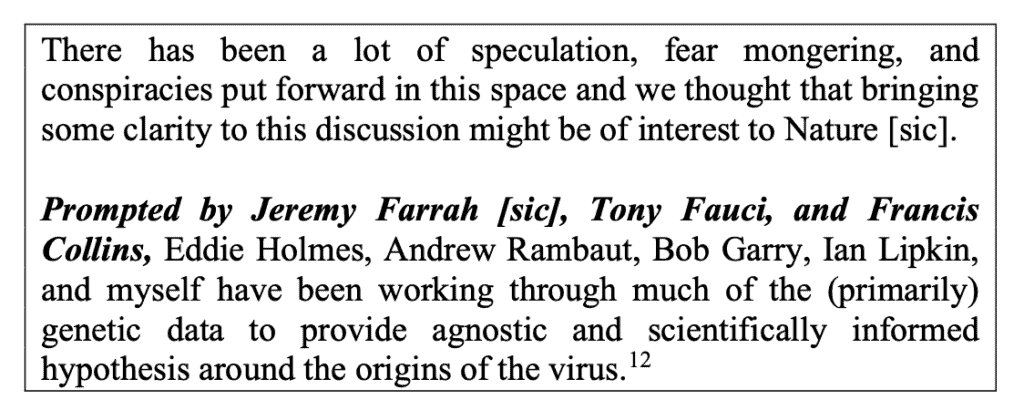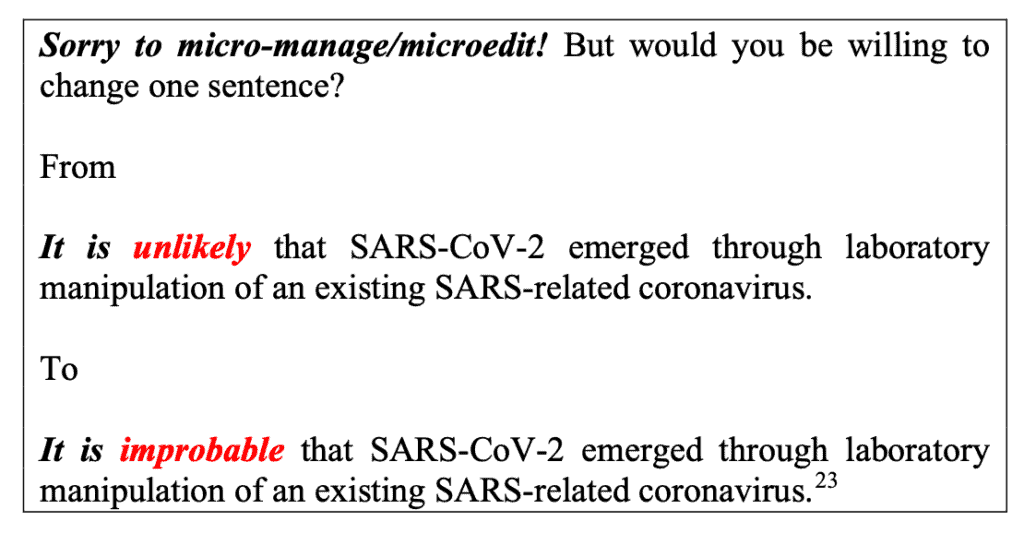
Virologists who worked to squelch consideration of a lab origin of COVID-19 in early 2020 worked in tandem with leaders in scientific research funding, according to their private emails.
Leaders of the National Institutes of Health in the United States and the Wellcome Trust in the United Kingdom played an undisclosed role in persuading virologists to write an influential article asserting a natural origin of SARS-CoV-2, according to a memo released Sunday by investigators with the Select Subcommittee on the Coronavirus Pandemic.
By mid-February 2020, social media sites in the West and in China buzzed with speculation about a possible connection between the emerging novel coronavirus pandemic and labs specializing in coronaviruses at its epicenter.
The “lab leak theory” cast suspicion not only on the Wuhan Institute of Virology and its neighboring labs, but also on their esteemed funders and collaborators in the West.
A March 2020 paper in Nature Medicine titled “The proximal origin of SARS-CoV-2” assured the public that the virus’ genome demonstrated an origin in wildlife. Hundreds of news organizations cited the article to assert that the lab leak theory was a “conspiracy theory.”
But the new congressional memo shows that the lead author of the article told the scientific journal that the writing had been “prompted” by then-Wellcome Trust Director Jeremy Farrar, leader of NIH’s National Institute of Allergy and Infectious Diseases Anthony Fauci, and NIH Director Francis Collins.
The virologists met with Farrar, Fauci and Collins in a private teleconference on February 1, 2020, emails released under the Freedom of Information Act have shown — a meeting some scientists have criticized as improper.
“There has been a lot of speculation, fear mongering, and conspiracies put forward in this space,” acknowledged lead author Kristian Andersen in a February 12 email, according to the new memo.
“Prompted by Jeremy Farrah [sic], Tony Fauci, and Francis Collins, Eddie Holmes, Andrew Rambaut, Bob Garry, Ian Lipkin, and myself have been working through much of the (primarily) genetic data to provide agnostic and scientifically informed hypothesis around the origin of the virus,” continued Andersen, a virologist with Scripps Research.

The involvement of heavyweights in scientific funding in the article was not disclosed to the public.
NIH funded gain-of-function research in Wuhan that strengthened SARS-related viruses, an NIH letter confirmed in 2021. Emails exchanged by Collins and Fauci and a private meeting between Fauci and a gain-of-function virologist in February 2020 suggests they were concerned about this connection in the days prior to the article being drafted.
While Wellcome is among the world’s largest philanthropies, a link between Wellcome and the lab complex in Wuhan has not been established. A spokesperson for Wellcome did not respond to a request for comment.
Farrar — who was recently appointed as chief scientist of the World Health Organization — shepherded the paper and made small edits to the article, the new congressional memo shows.
Farrar asked Andersen to change the sentence “it is unlikely that SARS-CoV-2 emerged through laboratory manipulation of an existing SARS-related coronavirus.” He suggested changing “unlikely” to “improbable.” Andersen agreed.

Farrar said he would push Nature to publish the article. Its sister publication Nature Medicine would eventually publish the manuscript a few weeks later. Parent company Springer Nature did not immediately respond to a request for comment.
The involvement of Collins, Fauci and Farrar in the article was not disclosed until it was made apparent in a Freedom of Information Act lawsuit in June 2021, 15 months after the article had first made its enormous impact.
The virologists have given shifting explanations of the purpose of the article, the new memo also shows.
When hoping to demonstrate their integrity to the journal, Andersen said discussion of the evidence had been “agnostic.”
However when speaking to gain-of-function virologists who did not want to give credence to the possibility of a lab origin at all, the authors assured them that their purpose was to demonstrate the lab leak theory was outlandish from the jump.
“Our main work over the past couple of weeks has been to disprove any type of lab theory,” Andersen wrote in an email on February 8, 2020.
NIH’s office of the director, NIAID and the Wellcome Trust did not immediately respond to requests for comment.
“The SARS-CoV-2 sequence was released in mid-January 2020 and by February scientists were trying to tell us where it came from. Actually, where it didn’t come from. That was premature by any call,” said virologist Simon Wain Hobson, an emeritus professor at the Institut Pasteur, who was not involved in the article. “Arguments of authority don’t wash. Data counts. Science needs time.”
The virologists’ article was cited by Fauci and the mainstream media to push back on claims that SARS-CoV-2 was a bioweapon among hawkish politicians in the U.S. But the new congressional memo also shows that the virologists were motivated at least in part by concerns about discussion of the possibility among regular Chinese citizens.
‘Pre-adapted’
The virologists behind the “proximal origin” article have strongly denounced accusations they were improperly swayed by the participation of influential funders of scientific research. They have asserted that they seriously considered the lab leak theory but that evidence accumulated in favor of a natural origin, assuaging their earlier concerns about the Wuhan lab.
However the congressional memo raises new questions about the idea that the virologists ever seriously considered the lab leak theory.
Columbia University virologist Ian Lipkin wrote on February 11, 2020, that an early draft of the article “does not eliminate the possibility of inadvertent release following adaptation through selection in culture at the institute in Wuhan,” citing a “nightmare of circumstantial evidence” at the Wuhan lab.
The new congressional memo shows for the first time that Holmes wrote on February 11, 2020, that he agreed with Lipkin’s assessment, even after he had drafted the first version of the article that would dispel the lab leak theory.
Holmes also said he had concerns about how quickly the virus had emerged in humans, apparently without detection in a likely zoonotic reservoir, in contrast to the SARS epidemic.
“It is indeed striking that this virus is so closely related to SARS yet is behaving so differently. Seems to have been pre-adapted for human spread since the get go,” Holmes said.

The “proximal origin” article nodded to the fact that SARS-CoV-2 appeared pre-adapted to humans.
But scientists who have stated that SARS-CoV-2 appeared pre-adapted to humans in more straightforward terms, and who left open the possibility that the adaptation had occurred in the lab, have received fierce backlash.
The pangolin data
Questions about the integrity of the impactful “proximal origin” article first swirled nearly two years ago.
A series of emails released under FOIA in 2021 and 2022 demonstrated that the authors had expressed private concerns about a lab origin before doing a public about-face.
“Andersen wrote on January 31, 2020, that he, Holmes and Tulane University virologist Robert Garry found that “the genome looks inconsistent with natural evolution.”
Garry wrote on February 2, 2020, that he could not understand how SARS-CoV-2 could have emerged naturally after comparing its genome to a highly similar virus at the Wuhan Institute of Virology: “I just can’t figure out how this gets accomplished in nature. Do the alignment of the spikes at the amino acid level … stunning.”
Yet the “proximal origin” article asserted that any lab origin theory was implausible.
Congressional Republicans have sought answers about whether the private teleconference with powerful funders of scientific research on February 1, 2020, had an improper influence.
The virologists have rebutted that claim in part by pointing to the emergence of data in China describing coronavirus data suggesting a highly similar receptor binding domain in pangolins around the same time they were drafting the article.
Pangolins are highly trafficked in China, though rarely sold live in wet markets.
But the new congressional memo suggests that Andersen, the article’s lead author, did not find that the pangolin data alone provided sufficient evidence in favor of a natural origin.
“The newly available pangolin sequences do not elucidate the origin of SARS-CoV-2 or refute a lab origin,” Andersen said in an email on February 21, 2020. “[T]here is no evidence on present data that the pangolin CoVs are directly related to the COVID-19 epidemic.”
Congressional investigators state in the memo that given the pangolin data was apparently not the compelling evidence in favor of a natural origin theory, the factor that likely pushed the scientists toward the natural origin theory was undue influence by Collins, Fauci and Farrar.
“The pangolin data was not the compelling factor,” the memo reads. “To this day, the only known intervening event was the February 1 conference call with Dr. Fauci.”

Meanwhile, Stanley Perlman, a University of Iowa virologist who edited one of the papers describing the pangolin coronavirus data, said that the new congressional memo has not changed his stance in favor of a natural origin. However the publication did issue a correction stating that pangolins were an unlikely intermediate host in 2021.
The committee also asserts that Andersen’s private statements contradict assertions made by a lawyer for Scripps Research in an August 2021 letter.
Asked about the apparent discrepancies, a Republican aide responded that “the select subcommittee is continuing to evaluate all available evidence, including whether or not Dr. Andersen was truthful to the committee.”
Asked whether the scientists scrutinized in the memo, including Fauci, would be called to testify, the aide said that “the select subcommittee previously requested their testimony and those plans have not changed.”
Despite the scrutiny that has fallen on Fauci — President Joe Biden’s former chief medical adviser — Select Subcommittee on the Coronavirus Pandemic Chair Brad Wenstrup, R-Ohio, said in a Face the Nation interview Sunday that the investigation would seek to work in bipartisan fashion.
“I just want to get to facts,” Wenstrup said. “There’s going to be some moments, I’m sure, of some emotions flaring. The last three years have been tough on everybody.”
